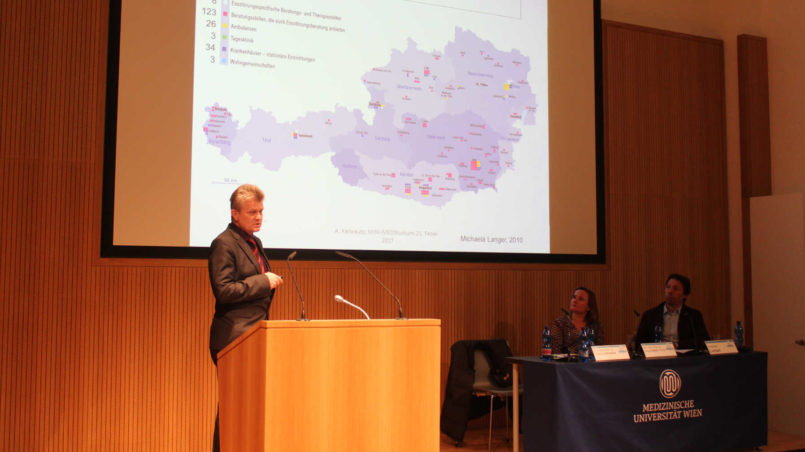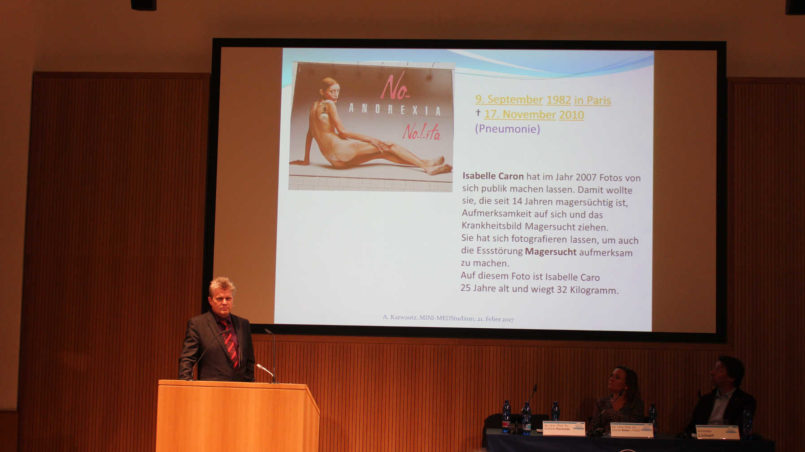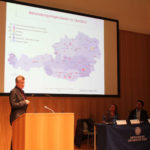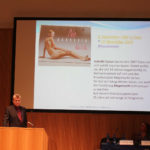Anorexia nervosa
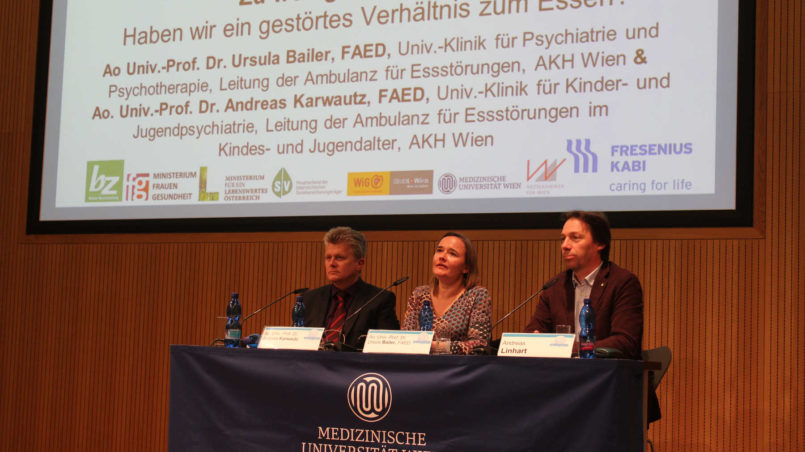
Event data
- Datum
- 21. 2. 2017
- Host
- Mini-Med Studium
- Location
- Van-Swieten-Saal der Medizinischen Universität Wien
- Event-type
- Vortrag
- Participants
- Ao. Univ.-Prof. Dr. Andreas Karwautz, Univ.-Klinik für Kinder- und Jugendpsychiatrie, Leitung der Ambulanz für Essstörungen im Kindes- und Jugendalter, AKH Wien
On February 21st 2017, a mini med lecture on the topic “Too little and too much: do we have a disturbed relationship to food?” took place in the Van-Swieten-Hall of the Meduni Wien at 7:00 pm. Renowned Prof. Andreas Karwautz (head of the outpatient department for eating disorders in childhood and adolescence at the AKH – the General Hospital – Vienna) as well as Prof. Ursula Bailer (head of the outpatient department for eating disorders at AKH Vienna) were present as speakers. The first part on anorexia nervosa was presented by Prof. Karwautz.
Professor Karwautz began his lecture with the following words: “I have been dealing with this topic for 25 years (…). It is not a particularly easy job to do, believe you me on.” At the same time, he also emphasized the fact that patients with eating disorders are valuable people and that are also a great joy to work with.
Anorexia nervosa
According to Prof. Karwautz, eating disorders can occur in the entire spectrum – between voluptuous femininity and the socially ideal slimness. The quote from the then 35-year-old Kate Moss, “Nothing tastes as good as skinny feels“, he describes as a disaster for himself and his professional colleagues, as this can already be an incentive for the gateway into anorexia or other eating disorders. This is especially the case if such statements are met by self-conscious minds.
The following six symptoms are present in practically all eating disorders:
- Distortion of body perception (perceiving oneself differently than one actually is)
- Focus on physique and weight phobia
- Reduction of food intake
- Reduction of food variety
- Binge eating
- Compensatory measures to prevent weight gain
Other specific symptoms include regurgitating food as well as chewing and spitting out food.
The criteria of anorexia nervosa according to ICD-10:
- An actual body weight of at least 15% below the expected weight or a body mass index of 17.5 or less (in adults)
- The weight loss is self-imposed by avoiding energy-efficient food and additionally at least one of the following possibilities:
- Self-induced vomiting
- Self-induced purging
- Exaggerated physical activity
- Use of appetite suppressants and / or diuretics
- Body perception disorder in the form of a specific mental disorder
- Endocrine disorders, manifest in women as amenorrhea, in men as libido and potency loss
- In case of onset of the disease predating puberty, pubertal development is disrupted (growth stop, lack of breast development)
Using photos, Prof. Karwautz also briefly demonstrated the phenomena “Bikini Bridge“, “Thigh Gap” “Collarbone” or “Bellybutton Challenge“, “A4 waist challenge“, which are used as a means of competition by young girls, especially in social media.
Of the two subtypes of anorexia nervosa, the “restrictive type” and the “purging type”, from the medical point of view, the latter is more worrisome. In addition to a limited caloric intake, this type also involves excessive exercise or the use of laxatives. In addition to intensive medical stays, there is a risk of death in the worst case.
A complete lack of insight as to physical damage already caused by the disease is also typical.
As with any addiction, anorexia also “gives” the patient something. In a large survey among patients with eating disorders, they indicated that, among others, the gained “security”, “strength” and “self-confidence” from the disease. This is therefore considered to be the core task for therapists. If the disease is to be overcome, it is vital to ensure that the patient can gain safety, strength, etc. from other areas.
The most serious cases, however, are those in which the disease is “identity-forming”. If the person identifies with the disease, an influence is very difficult. Prof. Karwautz has very rarely come across the “deathwish” as a motive in practice.
As a doctor, it is therefore important to clarify other disorders, in addition to eating disorders, which may require treatment.
Frequencies of occurence of anorexia
The lifetime prevalence (frequency in the course of a lifetime) is at a maximum of 4%, the point prevalence (frequency at a certain point in time) is about 0.2 to 0.8%. It usually begins between the 13th and 17th year of a person. The average treatment duration of 5 years is to be considered long. Hence it is the third most common long-term chronic disease in adolescents (after asthma and obesity).
Author’s Note: Subsyndromal symptoms of an eating disorder (symptoms that are not strong enough for diagnosis as a clinically recognized syndrome) show in 21.9% of all 11- to 17-year-olds according to a study by the Robert-Koch-Institute (Source: Children- und Youth Health Survey KIGGS of the Robert Koch Institute on the Health of Children and Adolescents in Germany).
Risk factors of anorexia
In order to address only the most important findings, Prof. Karwautz named female sex, a genetic component (which amounts to about 50% and is a disturbance of the regulation of the neurotransmitter system), personality factors, family and social risk factors.
Therapy of anorexia
The tasks of the treating person are first to advise and initiate self-help (for example, with the help of books). Treatment should be conducted on an out-patient basis and as far as possible, should be interdisciplinary in nature (specialists, psychotherapists, etc.). If out-patient treatment is not sufficient, in-patient therapy is recommended, if possible within the framework of centers with special expertise for this disease. Unfortunately, there is no specialized clinic in Austria for eating disorders which basically says so “on the wrapping”.
Each institution uses its own concept; in addition to doctors, nurses, psychologists, psychotherapists, dietologists, educators and social workers also work on the patients as part of a multidisciplinary approach. There is very much to be done, as there are often problems in different areas of life. All these problems have to be addressed, since otherwise convalescence is not possible.
The best possible treatment is only possible if the disease is detected early. Unfortunately, patients coming to the clinics have often already been ill for a very long time or very seriously.
Since, according to the latest research, the hunger state perpetuates the vicious circle, it is very important to strive for the patient to gain weight at an early stage. The “developmental dead end” maneuvred into by the eating disorder can hardly be left by children/adolescents without the parents’ involvement as a resource. As a clinician it is absolutely necessary to have “patience and perseverance”; after all, an average treatment period of five to six years is expected. Dr. Karwautz advises impatient clinicians to stay away from eating disorders.
In particular, the parents of anorectic children suffer from massive pressure and stress, which is comparable to having a child with schizophrenia (the most severe illness of psychiatry at all). For this reason, a support program for parents of children with eating disorders is currently being offered at the AKH. This program is very well received and two-thirds of the program has already been carried out.
Prof. Karwautz then devotes himself to the case of Isabelle Caro. In 2007 she allowed herself to be photographed naked for a campaign against anorexia. Due to complaints, the posters in Paris were removed after a few days. Caro herself wanted to show how you look after a decade of anorexia and, by so doing, give a warning to others. At 25, Caro ultimately died of the consequences of her anorexia, pneumonia, with a weight of 32 kilos.
Course of the disease
Although Dr. Karwautz has already treated more than 1,000 young people, not one of his patients have died in their youth. If at all, then an anorectic dies when an adult, after years of illness. Approx. 6000 patients worldwide die of the disease annually. However, for 75-80% of those affected a cure is possible.
Conclusion
Within the framework of a conclusion, Prof. Karwautz stressed that healing was possible, but that it required a great deal of patience.
A prolonged period of treatment results, in particular, from the lack of motivation of the persons concerned for therapy, errors in the appropriate treatment, lack of understandung on the part of their environment, as well as a non-recognition of the disease. If a personal suspicion arises, Prof. Karwautz advises to openly adress it.
Orthorexia
Orthorexia (“pathological healthy eating”) was first described in 1997 in the Yoga Journal and describes people who only eat explicitly healthy food, shop only at the organic food store, and so on. This was probably the result of a great fear that something wrong might happen in the case of the intake of the wrong food (something unhealthy). One could get the impression that this disease is increasing, after all, this is shown by different studies.
However, since the methods used varied greatly, the prevalence found also varied between 6% and 90% of the population. Prof. Karwautz describes this as “worthless”. In a more recent study, the pressure of suffering was also taken into account because it plays a major role in the disease. This improved study had a prevalence of less than 1%, which convinces Prof. Karwautz believes to be closer to the truth. He describes the “hype” around the orthorexia as misguided.
With these words, Prof. Karwautz concludes his lecture and thus the first part of the event. In the second part, Prof. Dr. Ursula Bailer FAED, head of the out-patient clinic for eating disorders at the AKH Vienna, will speak on binge eating disorders as well as bulimia nervosa.
Translation from German: Serena Nebo

